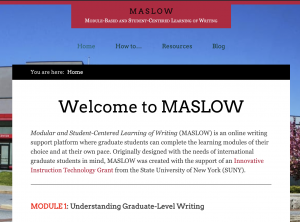I was recently participating in a webinar about a MOOC-style first-year writing course, and a few words kept confusing me. Content. Delivery. Scale. . . . Especially the last one stops me in my tracks.
SCALING?
When Tenzing Norgay Sherpa and Edmund Hillary climbed Mt. Everest for the first time, they weren’t doing numbers. They were undertaking a superhuman challenge. It was a qualitative matter. It was a matter of inspiration. Making the impossible accessible. Showing that someone could actually do it. Redefining success. “Because it was there.” It, the mountain that had killed countless people for trying. They were scaling the un-scale-able.
“The real value add[ed] of higher education,” says Joshua Kim, writing on Inside HigherEd, “cannot occur at web scale. It can only occur at human scale.” That scale occurs “where a skilled and passionate educator interacts directly with a student to guide and shape their learning.” As Kim adds, in an article meant to debunk myths and criticism of open, at-scale online education (not a critique of it), “[o]pen online courses at scale expose just how valuable, essential, and irreplaceable are our tight-knit learning communities. Never before has the teaching efforts of a gifted, knowledgeable and passionate instructor . . . been as valuable and as essential.” Online education at scale has to somehow find ways to substitute one-on-one and/or face-to-face human interaction, decreasing the time and attention given by an educator to learners who can ask questions, feel the presence. In a writing class, only some things can be scaled without fundamentally compromising learning.
Lexically, scale is not just an instrument for weighing or measuring but also the act of “climbing” or “increasing something by numbers.” In math and music, scale refers to relative position or variation. When business or education is done at scale, it must be calibrated and adjusted to the larger scope. Proportional impact and commensurate quality is strived for but not certain at all. The idea of scale as “levels” implies social ranking and also ways of measuring or ranking something. It implies hierarchy. The word’s connotation of magnitude (often negatively) connects it again to the qualitative meaning scope/extent or reach/access. And, as I implied at the beginning, scale means to climb (from Latin “scalare”), with the connotation of difficulty or boldness in overcoming it, as in scaling the Mt. Everest.
That brings me to an argument I’ve been trying to make for a few years now: Why do advocates of online education seldom talk about scaling beyond the numbers? Can’t we scale teaching and learning by quality as well? Why don’t we try to scale them in terms of access and inspiration for the learners, rather than in terms of reach and impact by those who want to deliver the same content to more students? How about scaling the qualitative impact by using technology to boost interaction, foster motivation and agency, create community, make learners more independent and self-driven?
 In fact, along with a colleague, I’ve been developing a platform for graduate-level writing course where we’re letting students choose the learning units (modules) of their choice and learn as much as they want (in addition to minimum to pass the course, which is pass/fail graded). That’s a topic for another day—-let me just link the MASLOW project that Cynthia Davidson and I have developed.
In fact, along with a colleague, I’ve been developing a platform for graduate-level writing course where we’re letting students choose the learning units (modules) of their choice and learn as much as they want (in addition to minimum to pass the course, which is pass/fail graded). That’s a topic for another day—-let me just link the MASLOW project that Cynthia Davidson and I have developed.
DELIVERING?
What is the “content” of a writing course? Whatever text (and the “content” in them) that its instructor assigns students, right? That content may be basic “knowledge” of terms and concepts, skills and conventions that students need to acquire—-or knowledge “about” citation guidelines, punctuation rules, rhetorical terms, knowledge about genres and conventions of writing, strategies for analyzing texts or engaging sources. But that’s the teaching “about” writing part of teaching writing, a small part of course objectives in most cases. We might spend about ten percent of our class time teaching about writing. To teach “content” about writing, and to add illustration through videocapturing, I have often created videos, encouraging students to watch them, so we can use class time for more discussion and practice. But students didn’t like it. Nor did I. I hated using the “content” from one year to the next; I want to cover new issues, approach them differently, and so on. I would rather find the ten percent class time and integrate content within interaction and practice more seamlessly. It’s the “process” of discussion and research, reading and analysis, drafting and feedback, revision and critique … that really matters in a writing class. My classes are too far off the content base. Briefly, I teach first-year college writing where “content” and “testing” are marginal to learning objectives (students have robust intellectual discussion of issues they collectively choose to read about, analyzing academic writing as they both emulate and critique in their own writing), upper division professional and cross-cultural communication (students interview professionals in their disciplines or workplaces of their interest, or interview peers from around the world, as they practice writing skills and build their professional profiles), and graduate-level academic writing (students analyze genres of writing and study communication in their fields as “disciplinary ethnographers” while applying the skills they practice and knowledge they develop in class to a major writing project such as a grant proposal or journal article).
Content can be “delivered,” teaching cannot be. Teaching writing, even the knowledge of it, which should come while engaging in skill development, is harder to “deliver.” I have a strong feeling that emerging technologies and support services are too often developed by experts who cannot account for the wide varieties of pedagogies used by scholars across the disciplines or even the varieties of curricular objectives. Think about the MOOC “revolution” which brought back “broadcasting” as a primary mode of education from the days of radio and television based distance learning! Especially in the country I teach now, the United States, college professors change our courses “on the fly” as well as every time we go to our conferences and come home filled with new ideas. We experiment. We function well After Pedagogy, as the title of a book by a fellow writing scholar puts it. We constantly disrupt our own practices (but typically don’t want others doing it for us). And, more importantly, we don’t want to repeat. To bore ourselves to death. This is why the most disruptive “innovators” quickly get frustrated by us and move on to try to disrupt something else. Writing teachers don’t really do content, so, there’s little to disrupt about how we deliver it!




